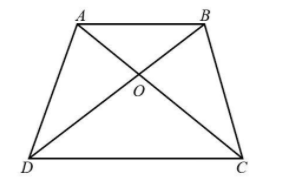Answer
391.2k+ views
Hint: Here, we will use the property that if two triangles lying on the same base have the same area then they both lie between a pair of parallel lines.
Complete Step-by-step Solution
The area of triangles $AOD$and $BOC$are equal that is $ar(AOD) = ar(BOC)$.
To prove that
ABCD is a trapezium.
We can observe from the diagram that in a quadrilateral ABCD the area of the triangle AOD and BOC are equal, we get,
$ar(AOD) = ar(BOC)$
Now, on adding area of triangle $ar(COD)$ on both the sides in the above expression $ar(AOD) = ar(BOC)$, we get the relation,
$ar(AOD) + ar(COD) = ar(BOC) + ar(COD)$
If we observe the diagram, then we can say that in the quadrilateral ABCD the area of triangle AOD and COD is equal to area of triangle ADC that is $ar(AOD) + ar(COD) = ar(ADC)$ and the area of triangle BOC and COD is equal to area of triangle BCD that is $ar(BOC) + ar(COD) = ar(BCD)$.
On putting $ar(AOD) + ar(COD) = ar(ADC)$ and $ar(BOC) + ar(COD) = ar(BCD)$in the above expression, we get the required relation.
$ar(ADC) = ar(BCD)$
Since, we know that ADC and BCD are two triangles of the same area and lie on the same base CD then $AB\parallel CD$.
Therefore, in quadrilateral ABCD one pair of opposite sides is parallel, that is $AB\parallel CD$. Hence, ABCD is a trapezium.
Note: The condition to obtain a trapezium from a quadrilateral is that one pair of opposite sides should be parallel to each other.
Complete Step-by-step Solution
The area of triangles $AOD$and $BOC$are equal that is $ar(AOD) = ar(BOC)$.
To prove that
ABCD is a trapezium.
We can observe from the diagram that in a quadrilateral ABCD the area of the triangle AOD and BOC are equal, we get,
$ar(AOD) = ar(BOC)$
Now, on adding area of triangle $ar(COD)$ on both the sides in the above expression $ar(AOD) = ar(BOC)$, we get the relation,
$ar(AOD) + ar(COD) = ar(BOC) + ar(COD)$
If we observe the diagram, then we can say that in the quadrilateral ABCD the area of triangle AOD and COD is equal to area of triangle ADC that is $ar(AOD) + ar(COD) = ar(ADC)$ and the area of triangle BOC and COD is equal to area of triangle BCD that is $ar(BOC) + ar(COD) = ar(BCD)$.
On putting $ar(AOD) + ar(COD) = ar(ADC)$ and $ar(BOC) + ar(COD) = ar(BCD)$in the above expression, we get the required relation.
$ar(ADC) = ar(BCD)$
Since, we know that ADC and BCD are two triangles of the same area and lie on the same base CD then $AB\parallel CD$.
Therefore, in quadrilateral ABCD one pair of opposite sides is parallel, that is $AB\parallel CD$. Hence, ABCD is a trapezium.
Note: The condition to obtain a trapezium from a quadrilateral is that one pair of opposite sides should be parallel to each other.
Recently Updated Pages
The branch of science which deals with nature and natural class 10 physics CBSE

The Equation xxx + 2 is Satisfied when x is Equal to Class 10 Maths

Define absolute refractive index of a medium

Find out what do the algal bloom and redtides sign class 10 biology CBSE

Prove that the function fleft x right xn is continuous class 12 maths CBSE

Find the values of other five trigonometric functions class 10 maths CBSE

Trending doubts
State the differences between manure and fertilize class 8 biology CBSE

Why are xylem and phloem called complex tissues aBoth class 11 biology CBSE

Difference between Prokaryotic cell and Eukaryotic class 11 biology CBSE

Difference Between Plant Cell and Animal Cell

What would happen if plasma membrane ruptures or breaks class 11 biology CBSE

Give 10 examples for herbs , shrubs , climbers , creepers

What precautions do you take while observing the nucleus class 11 biology CBSE

What would happen to the life of a cell if there was class 11 biology CBSE

Change the following sentences into negative and interrogative class 10 english CBSE




